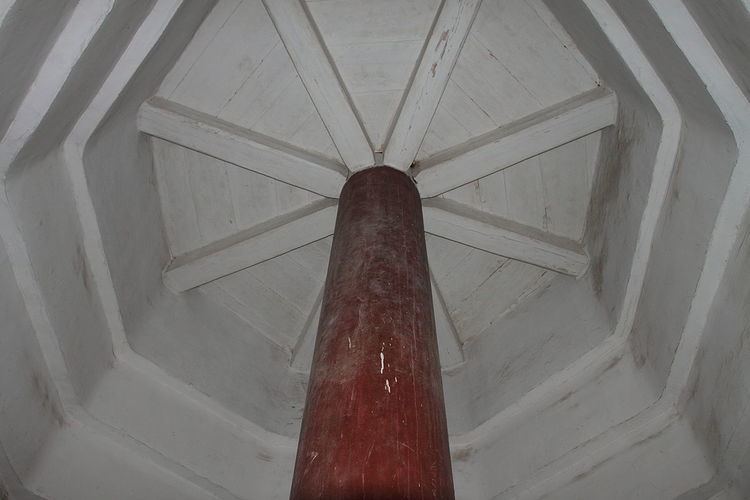 | ||
The shinbashira (心柱, also 真柱 or 刹/擦 satsu) refers to a central pillar at the core of a pagoda or similar structure.
Contents
The shinbashira has long been thought to be the key to the Japanese pagoda's exceptional earthquake resistance, when newer concrete buildings may collapse.
History
Hōryū-ji, the world's oldest wooden structure, was found to have in 2001 a shinbashira from a tree felled in 594 AD. Their examples continue in impending centuries in other tō (塔, pagoda) like the Hokkiji in Nara in 8th century, and Kaijūsenji of Kyoto.
Architecture
The pillar structure is made out of straight trunks of Japanese Cypress (hinoki). The pillar runs the entire (but see below) length of the pagoda, and juts out of the top 'layer' of the pagoda, where it supports the finial of the pagoda.
The initial architectural forms included the pillar ingrained deep within the foundation(shinso 心礎)Hōryūji Gojū-no-tou 法隆寺五重塔,(Gojū-no-tō: 5-layered-pagoda) was found to be 3m below ground level.
At this time, pillars were tapered and became roughly circular from the point where they rose beyond the roof, starting as hexagonal from the base. This shaping was necessary as metal pieces were fit to the central pillar to support the spire. Later uses starting 12c involve them suspended just above the ground, thus making them suspensions like the Nikkō Tōshōgū Gojū-no-tū 日光東照宮五重塔 (1818) in Tochigi prefecture.
Size had a bearing on the fragmentation of the pillars found in the 8th century. The central pillar of Gojuu-no-tou at Hōryūji has a height of 31.5 m with a diameter of 77.8 cm at base, 65.1 cm in the middle and approximately 24.1 cm at the midpoint on the spire. Such huge pillars had to be divided into three sections: from the base stone to the third floor; from the fourth story to the point where the spire begins, and the spire section. The shaft of a three-storied pagoda (sanjuu-no-tou 三重塔), is divided between the second and third stories and again where the spire begins. During the 8c, shinbashira were erected on a base stone set at ground level. Example: Hokkiji Sanjuuu-no-tou 法起寺三重塔 (742) in Nara. (see Earthquake Resistance below)
Earthquake resistance
Japan is an earthquake prone nation. Yet records show that only two of the pagodas have collapsed during the past 1,400 years owing to an earthquake. Hanshin earthquake in 1995 'killed 6,400 people, toppled elevated highways, flattened office blocks and devastated the port area of Kobe. Yet it left the magnificent five-storey pagoda at the Tō-ji Temple in nearby Kyoto unscathed, though it levelled a number of lower buildings in the neighbourhood.' The reason traditionally attributed has been the shinbashira; newer research shows that the very wide eaves also contribute to the inertial stability of the pagoda. Overall deductions have not been very simplistic.
Some of structural engineer Shuzo Ishida's model pagodas have a simulated shinbashira attached to the ground, as was common in pagodas built during the sixth to eighth centuries. Others simulate later designs with the shinbashira resting on a beam on the second floor or suspended from the fifth. Compared with a model with no shinbashira at all, Ishida finds that the one with a central column anchored to the ground survives longest, and is at least twice as strong as any other shinbashira arrangement. Studies about shinbashira and their quake resistant attributes have been many. These studies are now materializing even in brick-and-mortar buildings like the Tokyo Skytree. (see below) (see relevant links and citations for further reading on the other earthquake bearing of Japanese pagodas)
Modern uses
Pursuant studies of the shinbashira structure, and its utility in quake-resistance has made it to be used anew in structures including the Tokyo Skytree. A central feature of the tower is a system to control swaying used for the first time, has been dubbed "shinbashira" after the central pillar found in traditional five-story pagodas. The 375-meter-long, steel-reinforced concrete shinbashira is not directly connected to the tower itself and is designed to cancel out the swaying of the needle-like tower during an earthquake.
According to an official with Nikken Sekkei, which designed the structure, the concept was developed on the basis that pagodas rarely topple during earthquakes.See Article
More recently in San Francisco, the renovation of 680 Folsom Street, a fourteen-story 1960s steel building, inspired an ultra-modern iteration of the shinbashira: an 8-million-pound structural concrete core that can freely pivot atop a single sliding friction-pendulum bearing during a large earthquake. Tipping Mar, the engineering firm behind the design, used performance-based design and nonlinear time-history analysis to prove that the solution would meet the goals of the California Building Code. See Putting a Good Spin on Value Engineering.
